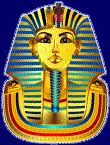Egyptian Gods and Goddesses

Egyptian Gods and Goddesses
Egyptian Mythology
Ever since time began people have wanted to know why certain thing happen. For example, they have wanted to know why earth was created and why the day changes to night. Today, people have scientific answers or theories about the world, but in earlier times, along with some places in the world today, people explained natural events in stories about gods, goddesses and heroes. These stories are known as myths and the study of myths is known as mythology.
Most myths can be divided into two groups: Creation myths and Explanatory myths.
Creation myths are those that try to explain the origin of the world, the creation of human beings and the birth of gods and goddesses. Explanatory myths are those that try to explain natural processes or events, and sometimes they deal with illness and death.
The Nile River plays an important part in Egyptian Mythology. As the Nile flows northward through Egypt, it carries a narrow ribbon of fertile land in the middle of a great desert. The sharp contrast between the fertility along the Nile and the wasteland of the desert became a main theme in many myths. The creatures that live in the Nile or along the banks, became linked with many gods and goddesses. The earliest information about Egyptian mythology comes from hieroglyphics on the walls of tombs, such as the burial chambers in pyramids.
There were many gods and goddesses in Ancient Egyptian beliefs. The gods and goddesses were different for each provinces and region of Egypt. Below is a list of some of the major gods and goddesses of Ancient Egypt.
Nun - represents chaos; the original ocean which before the creation lay the germs of all plants and animals. The Egyptians called him "Father of the Gods". Sometimes he was found represented as a figure plunged up to his waist in water, with his arms upreached to the gods.
Atum - his name comes from a root which means 'not to be'. He was recognised with Ra, the great sun god. Atum was represented as the setting sun and the sun before its rising and is always represented with a man's head, wearing the double crown of the pharaohs.
Horus - is the latin name of the Greek Horus. He was the title of the pharaoh in power. He was a solar god and was represented by a falcon or a falcon headed god.
Ra - the god of the sun, lord of the sky. Apparently humans and all other creatures came from Ra's tears.
Renenet - is the goddess of children. She protects every child at birth. In pictures and statues she appears as a woman with a cobra's head and is also the goddess of good fortune and riches.
Tetnut - is the goddess of moisture, rain and dew. She is the symbol of creation and has the head of a lion wearing a solar disk. She is a protector of Ra and the pharaoh.
Mayat - is the goddess of truth, justice and order of the universe. Her symbol is the feather and she is responsible for unity and order in the world. Her statue is of a woman with a single feather in her hair.
Nut - is the goddess of the sky and is said to be the mother of Ra. Her sign is the cow and she creates the darkness.
The spelling of the gods and goddesses names varies and some times this creates great confusion.
Household Gods
Thoueris the hippopotamus, and the little frog Hekat, were
believed to help when women were in labour. The Seven Hathors protected children and Renenutet, the cobra goddess, looked after the harvest. The ugly dwarf Bes brought everybody good luck. Egyptians, would paint their walls with these gods and goddesses and would wear amulets of them for good luck.
The Nome Gods
People would consult their Nome temple on festival day, bringing offerings before asking for help or advice from their special god. Families would take offerings of food to their tombs when their relatives died as they believed this kept their Ka or spirit alive so that they could hear.
Before Egypt united and became a nation, the tribes on the banks of the Nile used an animal for itís totem to protect them. It was usually something strong or graceful. Also every tribe had a hero or legend. They would build a nome temple on the place where they believed he died.
The National God
Heliopolis was protected by Re and then Re became responsible for the whole of Egypt, hence the name 'The National God'. The Nome gods used Re's name like the crocodile god who wears a sun disc and is called Sobek-Re. It is thought that because they use his name they are also able to use some of Re's power.
The Eye of Horus
The Udjat eye represents the eye of the god Horus which was ripped from his head by the storm god 'Seth'.
Home

